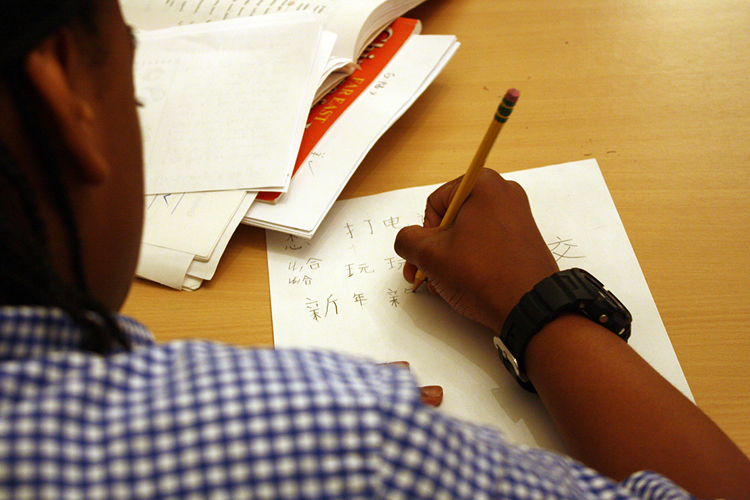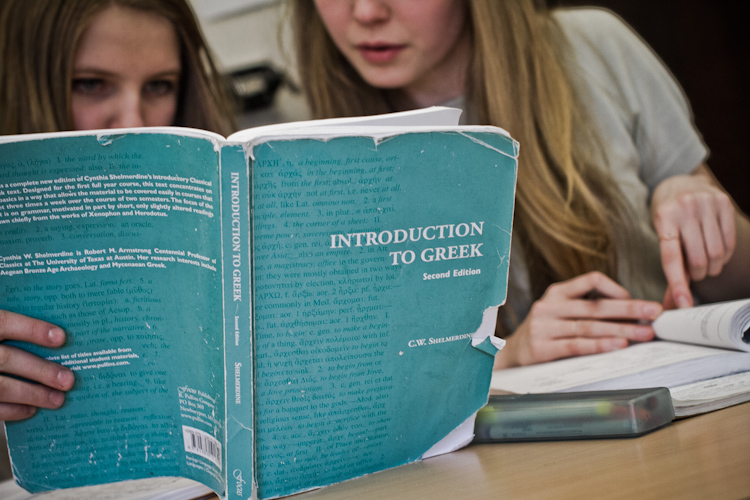High School Course Catalog |

Language
The study of language is first introduced at Saint Ann’s in the Lower School. We teach it as language arts. Beginning in the fourth grade, the language structures program takes formal charge of language studies in a three-year sequence beginning with the structures of English alone and culminating in the sixth grade in a comparison of English and Latin grammar. Seventh graders are eligible for language electives and may choose from a variety of classical and modern languages including Latin, Greek, Chinese, French, and Spanish, all of which continue through the High School. Eighth graders and high school students and may also elect Japanese.
When students enter the High School, they usually continue with the languages they have studied in middle school and, if they have not already done so, frequently choose a second or even third language. Language courses in the High School become more sophisticated and demanding. Oral and written work must reflect an increasingly complex knowledge of grammar and vocabulary. Placement in all electives is based primarily on demonstrated ability; thus any such course may be made up of students from different grade levels.
Modern and classical languages at Saint Ann’s supplement and are supplemented by courses in other departments. Students of Mandarin Chinese and Japanese may take advanced electives courses such as History of China or Modern East Asia offered by the History Department, and Spanish and French students may read the same literature in translation in an English course. Courses in European history as well as in theater richly enhance a romance language student’s appreciation of a classical l7th century play or the development of existential theater in the 20th century. This blending of disciplines gives students the experience of language as a primary source, a tool for conversation, and an irreplaceable means for understanding.
Language Structures
The beginning of the language structures program exemplifies in many ways how Saint Ann’s works. It was conceived in 1978 as the outgrowth of an experimental course for middle school students in the comparison of English and Latin grammar. The curriculum was designed over a period of time with the encouragement and suggestions of a number of faculty members. The department emerged in direct response to a perceived need for students to have a solid understanding of their own language and how it functions both separately and comparatively. It was clear that young middle school students worked adequately but without real confidence in dealing with languages other than English.
In fourth grade the curriculum emphasizes the nature of literature as a reflection of society. Toward that end, students read a variety of fairy tales and myths in an effort to discern the ethos of the people who produced them. As the year progresses, classes focus on folkloric writing, delving into the work of individual cultures and authors. Students are often asked to create their own fantastical worlds in response to texts. In their writing, they work on a narrative and purposive allusion, developing real stories that have a beginning and an end.
The fifth grade curriculum focuses on different types of writing, with an emphasis on genre and form. Special attention is given to memoir, mystery, comedy, and dystopias. The students read short fiction, novels, poems, and plays. Teachers concentrate on helping students experiment with each mode of expression in their own work. Beginning in January, the fifth graders select a topic for a three to five page research paper. Topics are drawn from the broader subject area of New York and students learn to use the research facilities in the library. The paper is intended to teach the students reading for facts and information from a variety of sources and then organizing that information into a viable whole.
By sixth grade, students are conceptually advanced enough to understand fully that languages exhibit complex structures. In the Introduction to Languages course, students consider a variety of languages as phenomena worthy of study on their own terms. By examining the morphology, syntax, phonetics, and lexicon of English (and, occasionally, other languages), students develop a structural framework with which they can account for the grammar of any human language. Concurrently they develop a working descriptive grammar of English. In the second half of the course students turn their attention to Latin, where they reconsider comparatively the grammatical concepts they developed in the first semester, while at the same time learning the skills to acquire another language.
The success of the language structures program has been remarkable. An emphasis on the different functions and forms of writing in the early years enables students to express themselves coherently and artfully on paper. The examination of the grammars of English and Latin, and the acquisition of grammatical terminology to describe any language, deepen their understanding of syntax, semantics, and morphology and position students to study foreign languages efficiently. Indeed, it is common for our students to reach high levels of proficiency in two languages. Many students will do the same with three.
The formal study of a foreign language at Saint Ann’s generally begins in the seventh grade. From time to time, exceptions are made for those students who come from bilingual homes, have lived in other countries, or are already proficient in a second language. Most seventh grade students have had the benefit of the three-year sequence in the language structures program and are therefore well-equipped to face the intricacies of a foreign language.
Asian Languages
Mandarin is offered from the seventh through twelfth grades. The course sequence covers: 1) the spelling system–Pin Yin; 2) phonetic rule–the four tones; 3) character writing–both traditional and simplified forms in accordance with the students’ preference; 4) conversation–idiomatic modern Chinese in current use among native speakers, especially everyday social communication and specific situations; 5) reading–stories, proverbs and idioms, poems, newspaper clips, and authentic Chinese literature works at advanced levels. The annual celebrations of the Moon Festival and the Chinese New Year provide students with opportunities to further their understanding of Chinese history, culture and traditions while writing calligraphy, making lanterns, singing Chinese songs, etc. Language studies are also supplemented and enriched by a wealth of information about Chinese current events, history, geographic regions, pop culture, and local customs and traditions that are discussed in class and explored through slide shows, films, field trips and guest speakers.
Japanese is offered as a language elective beginning in eighth grade. The first two years focus on basic sentence structures, verb and adjective conjugations and vocabulary. The emphasis in the first year course is on mastering the two phonetic systems, Hiragana and Katakana. Kanji (Chinese characters) is also introduced. The second year builds on the first, adding an emphasis on composition. The students are also introduced to a variety of social situations in which the use of keigo or honorifics is required. The third, fourth, and fifth years continue the emphasis on speaking, writing, listening, and reading to allow continued growth in the mastery of Japanese. In Japanese Conversation, students further their ability to function in various social situations with greater spontaneity, following cultural codes. In each of the grades we continuously explore Japanese culture and traditions from ancient periods to current popular trends through extensive examination of Japanese history, philosophy, art, etc.

Classical Languages
Both Latin and Greek are offered as full-time languages. In the first two years of the beginner Latin course (seventh and eighth grades) students are introduced to all of the forms and syntax necessary to read Roman authors in the original. By the second half of the eighth grade, students often begin reading the Latin prose and poetry of ancient authors. The intermediate course, Poetry, Prose, Drama and the Novel, teaches selections from authors including Petronius, Plautus, Catullus, Cicero, Sallust, Horace, Vergil, and Ovid. The course focuses on Latin literature as literature and serves as a grammar review that will enable the students to read Latin more quickly and more fluently. Having completed this course, students begin the elective program, first studying Vergil’s Aeneid, then choosing from electives such as: Livy; Skepticism; The Declines and Falls of Rome; Another Antiquity; Tacitus; and The Epyllia.
The Greek program closely parallels the Latin program. The first year focuses on acquiring basic forms, syntax, and vocabulary, in order to facilitate the reading of Greek authors. By the end of the first year, the students have gained enough mastery of grammar and vocabulary to read slightly adapted original Greek texts. The second year concludes the study of forms and complex syntax and serves as an introduction to translation of passages excerpted from Aristophanes, Apollodorus, and Plato among others. In the third year, students read Plato and sometimes a tragedy. In the fourth, fifth, and sixth years students elect courses such as: Homer, Odyssey; Homer, Iliad; Greek Tragedy: The Oresteia; One Thousand Years of Greek Writing; Sopholces’ Ajax and Philoctetes.
In both the Latin and Greek programs, high school students can take accelerated introductory courses that cover two years of material in one year.